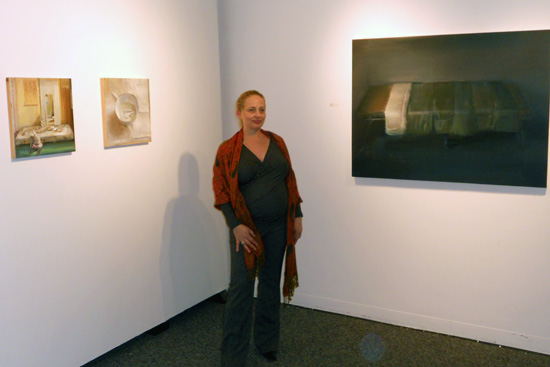The Dark Side of Domesticity
Sherman Gallery showcases work of CFA alums
One of the first artists to come to mind when thinking of interior genre painting is Johannes Vermeer. In exquisitely composed paintings like The Music Lesson and The Concert, we see the 17th-century Dutch artist’s mastery at capturing light, particularly as it falls from windows and plays across the objects in a room. The interiors of post-Impressionist painters Jean-Edouard Vuillard and Pierre Bonnard celebrate the creature comforts of 19th-century French bourgeois life. The genre has long been a favorite of American painters as well. Edward Hopper created haunting images of lonely figures inside diners, cinemas, and hotel lobbies. And that most quintessential of American artists, Andrew Wyeth, often turned his muted palette to the interiors of Maine and Pennsylvania farmhouses.
Now a new exhibition of psychologically charged paintings at the Sherman Gallery turns the whole genre on its head. Titled Shira Avidor & Cathy Lees: Interior Reflections, the show features the work of recent College of Fine Arts alums Shira Avidor (CFA’06), and Cathy Lees (CFA’07). While the two artists approach their subjects differently (Lees often appears in her own paintings, but human presence is noticeably absent in Avidor’s), both create what show curator Lynne Cooney (GRS’08,’15), School of Visual Arts exhibitions director, calls “provocative and brooding works.”
There is something menacing about many of the show’s images, particularly in Lees’ work. In Broken Eggs (above), a woman lies twisted on a kitchen floor, her feet and legs submerged in an open refrigerator, face turned away from the viewer. She is surrounded by broken eggs. Two wineglasses on the counter suggest that someone was there earlier. Is she dead? Was there a struggle? Has she collapsed in a fit of despair? And each egg has been cracked open so deliberately and precisely that you can’t help but ask, what happened here?
In Lees’ even more disquieting Bedroom Laundry, the eye is drawn first to a couple on a bed preparing to undress. But in a mirror is a shocking image: a woman folded into a laundry basket, the odd angles of her legs and arms making it appear that she’s been broken and stuffed into the basket.
Lees’ use of mirrors gives a sense of voyeurism. We glimpse interiors either through mirrors or through partially opened doors, suggesting that what we’re seeing is accidental, meant to be hidden.
“Some of the paintings actually include reflections,” says Lees, “while others invite the viewer to reflect on the mood and possible meaning of the scenes. Both Shira and I create darkly suggestive imagery.”

Such darkly suggestive imagery can be found everywhere in Avidor’s work. In Triptych, a set of three small still-lifes, we find no vase of flowers or bowl of glowing fruit. Instead, a skull sits on a tablecloth or atop a cake plate. But despite the disturbing subject matter, her monochromatic still-lifes have their own beauty.
Avidor’s interiors have a ghostly, spectral quality, as if people have abruptly left these rooms. In Reflection #1, children’s towels hang in a bathroom. A mirror reveals a child’s toy fish perched on a towel rack, one eye gazing warily out at the room. The painting seems to say, yes, people once lived here, but not now. In Interior #1, a small gift bag is on a stripped mattress, as though someone unwittingly left it behind. A poster of three skeletons on the wall suggests that only the dead inhabit this interior.
“There has always been an ongoing dialogue with the long tradition of the memento mori, remember your mortality, genre of painting in my work,” says Avidor, who admits to a fondness for “flickering images where past and present memories, feelings, and association converge, almost forcing the viewers to reexamine their own perceptions of their surroundings, which often become invisible.”
It’s possible that after viewing Interior Reflections, you’ll see something darker and more probing when you look at your own interiors.
Shira Avidor & Cathy Lees: Interior Reflections is on view at the Sherman Gallery, George Sherman Union, 775 Commonwealth Ave., second floor, through March 9. The gallery is open Tuesday to Friday, 11 a.m. to 5 p.m., and Saturday and Sunday, 1 to 5 p.m. The show is free and open to the public.

Comments & Discussion
Boston University moderates comments to facilitate an informed, substantive, civil conversation. Abusive, profane, self-promotional, misleading, incoherent or off-topic comments will be rejected. Moderators are staffed during regular business hours (EST) and can only accept comments written in English. Statistics or facts must include a citation or a link to the citation.